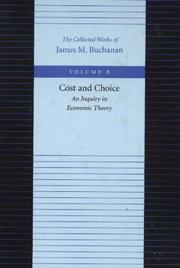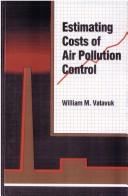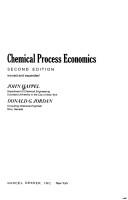| Listing 1 - 10 of 14 | << page >> |
Sort by
|
Periodical
ISSN: 19804814
Abstract | Keywords | Export | Availability | Bookmark
 Loading...
Loading...Choose an application
- Reference Manager
- EndNote
- RefWorks (Direct export to RefWorks)
costs --- costs strategic management --- management control --- costs accounting --- production costs --- services costs --- Cost control --- Cost --- Costs (Economics) --- Expenses --- Economics --- Contingent fees --- Containment, Cost --- Cost containment --- Cost reduction --- Costs, Industrial --- Cost control. --- Cost.

ISBN: 0691041989 1322885370 0691620806 0691647526 1400871085 9780691041988 Year: 1970 Volume: no. 4 Publisher: Princeton, N.J. Princeton University Press
Abstract | Keywords | Export | Availability | Bookmark
 Loading...
Loading...Choose an application
- Reference Manager
- EndNote
- RefWorks (Direct export to RefWorks)
A sequel to his frequently cited Cost and Production Functions (1953), this book offers a unified, comprehensive treatment of these functions which underlie the economic theory of production.The approach is axiomatic for a definition of technology, by mappings of input vectors into subsets of output vectors that represent the unconstrained technical possibilities of production. To provide a completely general means of characterizing a technology, an alternative to the production function, called the Distance Function, is introduced.The duality between cost function and production function is developed by introducing a cost correspondence, showing that these two functions are given in terms of each other by dual minimum problems.The special class of production structures called Homothetic is given more general definition and extended to technologies with multiple outputs.Originally published in 1971.The Princeton Legacy Library uses the latest print-on-demand technology to again make available previously out-of-print books from the distinguished backlist of Princeton University Press. These editions preserve the original texts of these important books while presenting them in durable paperback and hardcover editions. The goal of the Princeton Legacy Library is to vastly increase access to the rich scholarly heritage found in the thousands of books published by Princeton University Press since its founding in 1905.
Quantitative methods (economics) --- Cost --- Value --- Economics, Mathematical --- Coût --- Valeur --- Mathématiques économiques --- Coût --- Mathématiques économiques --- Mathématiques économiques. --- Economics, Mathematical. --- Coût de production. --- Costs, Industrial. --- Value. --- Cost. --- Fonctions de production. --- Production functions (Economic theory) --- Costs (Economics) --- Expenses --- Economics --- Contingent fees --- Standard of value --- Exchange --- Wealth --- Prices --- Supply and demand --- Mathematical economics --- Econometrics --- Mathematics --- Methodology --- Mathématiques économiques. --- Coût de production.
Book
ISBN: 0913966304 0913966355 Year: 1977 Publisher: Indianapolis Liberty Press
Abstract | Keywords | Export | Availability | Bookmark
 Loading...
Loading...Choose an application
- Reference Manager
- EndNote
- RefWorks (Direct export to RefWorks)
Economics --- Economics. --- Property. --- Inflation (Finance) --- Economie politique --- Propriété --- Inflation --- Cost --- Property --- #SBIB:33H000 --- #SBIB:024.IOS --- Possession (Law) --- Things (Law) --- Wealth --- Finance --- Natural rate of unemployment --- Economic theory --- Political economy --- Social sciences --- Economic man --- Costs (Economics) --- Expenses --- Contingent fees --- Economie: algemene werken --- Law and legislation --- Cost. --- Inflation (Finance). --- Propriété --- Primitive property

ISBN: 0865972230 0865972249 Year: 1999 Publisher: Indianapolis, Ind. Liberty Fund
Abstract | Keywords | Export | Availability | Bookmark
 Loading...
Loading...Choose an application
- Reference Manager
- EndNote
- RefWorks (Direct export to RefWorks)
Economics --- Cost. --- Opportunity costs. --- Social choice. --- Welfare economics. --- History. --- Cost --- Opportunity costs --- -Welfare economics --- Social choice --- 338.51 --- Choice, Social --- Collective choice --- Public choice --- Choice (Psychology) --- Social psychology --- Welfare economics --- Economic policy --- Social policy --- Economic theory --- Political economy --- Social sciences --- Economic man --- Alternative costs --- Costs, Alternative --- Costs, Opportunity --- Implicit costs --- Imputed costs --- Costs (Economics) --- Expenses --- Contingent fees --- History

ISBN: 0873711424 Year: 1991 Publisher: Chelsea, Mich. Lewis Publishers
Abstract | Keywords | Export | Availability | Bookmark
 Loading...
Loading...Choose an application
- Reference Manager
- EndNote
- RefWorks (Direct export to RefWorks)
Air --- Purification --- Equipment and supplies --- Costs. --- Estimates. --- Costs --- Estimates --- Air - Purification - Equipment and supplies - Costs. --- Air - Purification - Estimates. --- COST --- AIR POLLUTION --- AIR POLLUTION CONTROL --- Monograph --- Cost. --- Air contaminants --- Air pollutants --- Air pollution --- Air pollution control --- Air toxics --- Airborne pollutants --- Atmosphere --- Contaminants, Air --- Control of air pollution --- Pollutants, Air --- Toxics, Air --- Pollution --- Air quality --- Atmospheric deposition --- Costs (Economics) --- Expenses --- Economics --- Contingent fees --- Pollution. --- Control
Dissertation
ISBN: 3834941301 9786613698476 383494131X 1280788089 Year: 2012 Publisher: Wiesbaden ; New York : Springer Gabler,
Abstract | Keywords | Export | Availability | Bookmark
 Loading...
Loading...Choose an application
- Reference Manager
- EndNote
- RefWorks (Direct export to RefWorks)
Understanding cost behavior is a fundamental element of cost accounting and the management of a firm. Deviating from the traditional assumption of symmetric cost behavior, numerous recent research studies show that costs are sticky, that is, they decrease less when sales fall than they increase when sales rise. Daniel Baumgarten comprehensively analyzes the cost stickiness phenomenon by discussing its development and all relevant findings presented in the research literature. Furthermore, he provides several suggestions for future research and discusses important implications of cost stickiness for fundamental analysis and analysts’ forecasts by means of two comprehensive empirical analyses.
Auditing. --- Cost. --- Economics. --- Commerce --- Business & Economics --- Accounting --- Cost accounting. --- Cost --- Costing --- Costs, Industrial --- Costs (Economics) --- Expenses --- Business. --- Accounting. --- Bookkeeping. --- Business and Management. --- Accounting/Auditing. --- Historical costs (Accounting) --- Economics --- Contingent fees --- Accountancy --- Business enterprises --- Commercial accounting --- Finance --- Financial accounting --- Business --- Bookkeeping --- Bookkeeping . --- Double entry bookkeeping --- Business education
Book
ISBN: 9264161627 9264163700 9789264161627 Year: 1998 Publisher: Paris : OECD,
Abstract | Keywords | Export | Availability | Bookmark
 Loading...
Loading...Choose an application
- Reference Manager
- EndNote
- RefWorks (Direct export to RefWorks)
Electric power-plants --- Nuclear industry --- Coal-fired power plants --- Centrales électriques --- Industrie nucléaire --- Centrales au charbon --- Costs. --- Coût --- Electricity. --- Cost. --- ECONOMY --- Costs (Economics) --- Expenses --- Economics --- Contingent fees --- Galvanism --- Mathematical physics --- Physics --- Magnetism --- Monograph --- Electric utilities --- Prévision économique. --- Services publics d'électricité --- Énergie nucléaire. --- Costs --- Forecasting. --- Coût --- Prévision.
Book
ISBN: 146231841X 1452788383 1282845802 9786612845802 1451982666 Year: 2010 Publisher: Washington, D.C. : International Monetary Fund,
Abstract | Keywords | Export | Availability | Bookmark
 Loading...
Loading...Choose an application
- Reference Manager
- EndNote
- RefWorks (Direct export to RefWorks)
Reconciling the high frequency of price changes at the micro level and their apparent rigidity at the aggregate level has been the subject of considerable debate in macroeconomics recently. In this paper I show that incorporating production chains in a standard New- Keynesian model replicates two stylized facts about the data. First, sectoral prices respond with significantly different speeds to aggregate shocks. Meanwhile, the responses to sectorspecific shocks are similar. Second, the standard price setting models are unable to quantitatively match the amount of monetary non-neutrality observed in the data. I argue, First, that the input-output linkages in production generate different responses to aggregate shocks across sectors. Second, calibrating this model to the US data can create five times more monetary non-neutrality in response to nominal shocks compared to an equivalent homogeneous economy with intermediate inputs. Finally, the model implies that upstream industries respond faster to aggregate shocks compared to downstream industries. I show that this prediction is supported by the data.
Prices --- Cost. --- Government policy. --- Costs (Economics) --- Expenses --- Economics --- Contingent fees --- Government price policy --- Wage-price policy --- Macroeconomics --- Economic Theory --- Price Level --- Inflation --- Deflation --- Macroeconomics: Consumption --- Saving --- Wealth --- Energy: Demand and Supply --- Agriculture: Aggregate Supply and Demand Analysis --- Economic theory & philosophy --- Price adjustments --- Consumption --- Oil prices --- Supply shocks --- Sticky prices --- Supply and demand --- United States
Book
ISBN: 9781137278463 1137278463 Year: 2014 Publisher: New York Palgrave MacMillan
Abstract | Keywords | Export | Availability | Bookmark
 Loading...
Loading...Choose an application
- Reference Manager
- EndNote
- RefWorks (Direct export to RefWorks)
In The Zero Marginal Cost Society, New York Times bestselling author Jeremy Rifkin describes how the emerging Internet of Things is speeding us to an era of nearly free goods and services, precipitating the meteoric rise of a global Collaborative Commons and the eclipse of capitalism.Rifkin uncovers a paradox at the heart of capitalism that has propelled it to greatness but is now taking it to its death-the inherent entrepreneurial dynamism of competitive markets that drives productivity up and marginal costs down, enabling businesses to reduce the price of their goods and services in order to win over consumers and market share. (Marginal cost is the cost of producing additional units of a good or service, if fixed costs are not counted.) While economists have always welcomed a reduction in marginal cost, they never anticipated the possibility of a technological revolution that might bring marginal costs to near zero, making goods and services priceless, nearly free, and abundant, and no longer subject to market forces.Now, a formidable new technology infrastructure-the Internet of things (IoT)-is emerging with the potential of pushing large segments of economic life to near zero marginal cost in the years ahead. Rifkin describes how the Communication Internet is converging with a nascent Energy Internet and Logistics Internet to create a new technology platform that connects everything and everyone. Billions of sensors are being attached to natural resources, production lines, the electricity grid, logistics networks, recycling flows, and implanted in homes, offices, stores, vehicles, and even human beings, feeding Big Data into an IoT global neural network. Prosumers can connect to the network and use Big Data, analytics, and algorithms to accelerate efficiency, dramatically increase productivity, and lower the marginal cost of producing and sharing a wide range of products and services to near zero, just like they now do with information goods. The plummeting of marginal costs is spawning a hybrid economy-part capitalist market and part Collaborative Commons-with far reaching implications for society, according to Rifkin. Hundreds of millions of people are already transferring parts of their economic lives to the global Collaborative Commons. Prosumers are plugging into the fledgling IoT and making and sharing their own information, entertainment, green energy, and 3D-printed products at near zero marginal cost. They are also sharing cars, homes, clothes and other items via social media sites, rentals, redistribution clubs, and cooperatives at low or near zero marginal cost. Students are enrolling in free massive open online courses (MOOCs) that operate at near zero marginal cost. Social entrepreneurs are even bypassing the banking establishment and using crowdfunding to finance startup businesses as well as creating alternative currencies in the fledgling sharing economy. In this new world, social capital is as important as financial capital, access trumps ownership, sustainability supersedes consumerism, cooperation ousts competition, and exchange value in the capitalist marketplace is increasingly replaced by sharable value on the Collaborative Commons. Rifkin concludes that capitalism will remain with us, albeit in an increasingly streamlined role, primarily as an aggregator of network services and solutions, allowing it to flourish as a powerful niche player in the coming era. We are, however, says Rifkin, entering a world beyond markets where we are learning how to live together in an increasingly interdependent global Collaborative Commons.Bron : http://www.amazon.com
Economic order --- Capitalism --- Cooperation --- Cost --- 004.738.5 --- crowdfunding --- internet of things --- online netwerken --- 330.50 --- 330.55 --- 338.317.0 --- Costs (Economics) --- Expenses --- Economics --- Contingent fees --- Collaborative economy --- Cooperative distribution --- Cooperative movement --- Distribution, Cooperative --- Peer-to-peer economy --- Sharing economy --- Profit-sharing --- Market economy --- Profit --- Capital --- het internet --- Economische en sociale stelsels: algemeenheden. --- Coöperatief stelsel --- Coöperatief stelsel: algemeenheden. Coöperatieve vennootschappen --- Cooperation. --- Capitalisme --- Coût --- Coopération --- Internet --- Kapitalisme --- Coöperaties --- Kostenreductie --- Trends --- Trendwatching --- Economische theorieën --- Economische en sociale stelsels: algemeenheden --- Coöperatie --- Trend --- Economische theorie

ISBN: 0824761553 9780824761554 Year: 1975 Volume: 1 Publisher: New York, N.Y.: Dekker,
Abstract | Keywords | Export | Availability | Bookmark
 Loading...
Loading...Choose an application
- Reference Manager
- EndNote
- RefWorks (Direct export to RefWorks)
Chemical industry --- Mathematics --- 66.0 --- -Chemical industries --- Chemicals --- Man-made chemicals industry --- Synthetic chemicals industry --- Industries --- Chemical engineering. Chemical production, processing, operations, plant --- Manufacture and industry --- -Chemical engineering. Chemical production, processing, operations, plant --- 66.0 Chemical engineering. Chemical production, processing, operations, plant --- Chemical industries --- COST --- ECONOMICS --- MATHEMATICAL MODELS --- INDUSTRY --- CHEMICAL REACTIONS --- Monograph --- Cost. --- Economics. --- Mathematical models. --- Industries. --- Chemical reactions. --- Reactions, Chemical --- Chemical processes --- Industrial production --- Industry --- Economics --- Models, Mathematical --- Simulation methods --- Economic theory --- Political economy --- Social sciences --- Economic man --- Costs (Economics) --- Expenses --- Contingent fees --- Chemical industry - Mathematics
| Listing 1 - 10 of 14 | << page >> |
Sort by
|

 Search
Search Feedback
Feedback About UniCat
About UniCat  Help
Help News
News